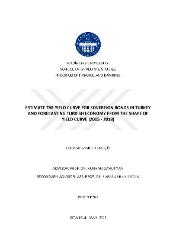| dc.contributor.advisor | Davutyan, Nurhan | en_US |
| dc.contributor.author | Temuçin, Teoman Samet | |
| dc.date.accessioned | 2020-01-20T08:13:32Z | |
| dc.date.available | 2020-01-20T08:13:32Z | |
| dc.date.issued | 2019 | |
| dc.identifier.uri | https://hdl.handle.net/20.500.12469/2709 | |
| dc.description.abstract | Yield curve that reflects the interest expectations of market participants is one of the
cornerstones of the financial analysis. In the first chapter of our study, Turkey yield
curve for sovereign bond market is estimated in 2005-2018 by using Extended NelsonSiegel (ENS) and Dynamic Nelson-Siegel (DNS) models. Since Turkish sovereign
market becomes more liquid and 10-year fixed rate coupon bonds were started to be
traded after 2010, this allows us to make estimation for 10-year term to maturity. As a
result of estimation via two methodologies, it is concluded that Dynamic Nelson-Siegel
model estimates Turkey yield curve slightly better than the Extended Nelson-Siegel
model. Besides, OLS (Ordinary Least Square) is better methodology than optimization
tools in DNS.
This is why, the estimated Turkey yield curve via Dynamic Nelson-Siegel model with
OLS methodology is used to forecast Turkish macroeconomic and financial indicators
in the second chapter of the study. The yield curve can be simply perceived as a
representation of interest rates of treasury bonds or other security instruments in
different maturities. However, that simple graph is beyond the representation of interest
rate. If it is read carefully, the market efficiency theory can be beaten and regular profits
from the market can be made. Many scholars and empirical studies of them have proved
the significant forecasting ability of the yield curve about recessions, turning points in
the stock market and inflation rates. Therefore, it seems as a reliable mechanism for
forecasting to some important indicators in the macroeconomic set. I also simply test the
forecasting capabilities of the estimated Turkey yield curve on Turkish recessions, bear
market, industrial production index, bist100 index and consumer price index. As a result
of analysis, it is concluded that parameters, which represent the Turkey’s yield curve,
contain important information and predictions regarding recessions, bear market
formation, bist100 index and consumer price index. | en_US |
| dc.description.abstract | Piyasa katılımcılarının faiz beklentilerini yansıtan verim eğrileri finansal analizin temel
taşlarından biridir. Tezin 1.Bölümü’nde, 2005-2018 yılları arasındaki Türkiye Hazine
kağıtlarının verim eğrileri Extended Nelson-Siegel (ENS) ve Dynamic Nelson-Siegel
(DNS) modelleri aracılığıyla tahmin edilmiştir. 2010 yılından sonra Türkiye menkul
kıymet piyasalarının daha likit olması ve 10 yıllık Hazine kağıtlarının işlem görmeye
başlaması, verim eğrisi tahminlerimizin 10 yıllık yapılmasına imkan tanımıştır. İki
metodoloji ile yaptığımız verim eğrisi tahminleri üzerinden ulaşılan sonuç: Dynamic
Nelson-Siegel modelinin Türkiye verim eğrilerini Extended Nelson-Siegel modelinden
bir miktar daha iyi tahmin ettiği yönündedir. DNS modeli içerisinde ise, OLS
yönteminin optimizasyon araçlarına göre daha iyi bir yöntem olduğu sonucuna
ulaşılmıştır.
Araştırmamızın 2.Bölümü’nde, Dynamic Nelson-Siegel modeli OLS yöntemiyle elde
edilen verim eğrileriyle, Türkiye makroekonomik ve finansal verileri tahmin edilmeye
çalışılmıştır. Verim eğrisi, farklı vadelerde hazine bonosu ya da diğer menkul
kıymetlerin faizlerini gösteren basit bir eğri olarak algılanabilir ancak söz konusu eğri,
faizlerin temsilinden çok daha öte bir anlam taşımaktadır. Verim eğrisi dikkatli
okunursa, piyasa etkinliği teorisi kırılabilir ve hatta piyasadan düzenli kârlar elde
edilebilir. Birçok akademisyen ve bilimsel araştırma, verim eğrisinin resesyonları,
borsadaki dönüş anlarını ve enflasyon oranlarını tahmin etmede anlamlı sonuçlar
verdiğini kanıtlanmıştır. Bu yüzden verim eğrisi, makroekonomik kümedeki bazı
göstergeleri tahmin etmek için güvenilir bir araç olarak gözükmektedir. Çalışmanın
2.bölümünde, ilk bölümde tahmin ettiğimiz Türkiye verim eğrisinin; Türkiye’deki
resesyonları, ayı piyasasını, sanayi üretim endeksini, bist100 endeksini ve enflasyon
oranlarını öngörebilme kabiliyeti test edilmiştir. Analizlerin sonucunda, Türkiye verim
eğrisini temsil eden parametrelerin, Türkiye’de resesyon, ayı piyasası oluşumu, bist100
endeksi ve tüketici fiyat endeksinin gelişimine ilişkin önemli bilgi ve öngörüler içerdiği
tespit edilmiştir. | en_US |
| dc.language.iso | eng | en_US |
| dc.publisher | Kadir Has Üniversitesi | en_US |
| dc.rights | info:eu-repo/semantics/openAccess | en_US |
| dc.subject | Sovereign Bonds | en_US |
| dc.subject | Yield Curve Estimation | en_US |
| dc.subject | Nelson Siegel | en_US |
| dc.subject | Turkey Yield Curve | en_US |
| dc.subject | Forecasting Recession | en_US |
| dc.subject | Bear Market and Inflation | en_US |
| dc.subject | Devlet Tahvili | en_US |
| dc.subject | Verim Eğrisi Tahmini | en_US |
| dc.subject | Nelson Siegel | en_US |
| dc.subject | Türkiye Verim Eğrisi | en_US |
| dc.subject | Resesyon | en_US |
| dc.subject | Ayı Piyasası ve Enflasyon Tahmini | en_US |
| dc.title | Estimate the yield curve for sovereign bonds in Turkey and forecasting Turkish economy from the shape of yield curve (2005 - 2018) | en_US |
| dc.type | masterThesis | en_US |
| dc.department | Enstitüler, Lisansüstü Eğitim Enstitüsü, İşletme Ana Bilim Dalı | en_US |
| dc.relation.publicationcategory | Tez | en_US |
| dc.identifier.yoktezid | 560465 | en_US |
















